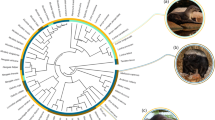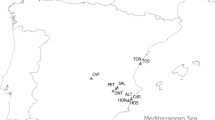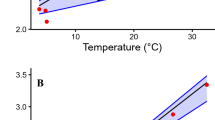Abstract
Pachygrapsus marmoratus is a semi-terrestrial crab and the most common grapsid crab in the intertidal belt of rocky shores throughout the Mediterranean Sea, Black Sea and northeastern Atlantic. In this study, the combined effects of temperature (T), body mass (M), and sex (S) on the routine oxygen consumption rate (R) in P. marmoratus were quantified. The blotted wet body mass of the specimens ranged between 43 mg and 18.0 g, and five test temperatures were used between 13.5 and 28.0°C. Six candidate models that reflected different assumptions regarding the dependence of R on S and T were compared. Model selection was based on Kullback–Leibler’s information theory and Akaike’s information criterion (AIC). The model \(R = \hbox{e}^{{A -E/{BT_{\rm a}}}} M^{b}\) had the highest support by the data (E is the activation energy, B = 8.618 × 10−5 eV K−1 is Boltzmann’s constant, T a is the absolute temperature in Kelvin, and b the allometric scaling exponent); for P. marmoratus it was found that \(R(\hbox{mg}\,\hbox{h}^{{- 1}}) = \hbox{e}^{{10.25 -{0.298} /{BT_{\rm a}}}} M^{{0.754}}.\) No sex dependence of R was supported by the data. Following a multi-model inference (MMI) approach, the mean (± SE) allometric exponent \(\hat{\bar{b}}\) was 0.750 (± 0.013) having a 95% (bootstrap) confidence interval of 0.726–0.774. Thus, it was established that P. marmoratus follows Kleiber’s 3/4 law, as seems to be generally true for intertidal crabs. The allometric exponent was independent of temperature as has also been reported for many other marine invertebrates (at normal temperatures). Q 10 values were relatively low, indicating wide thermal tolerance of the species. Model selection based on information theory is recommended for respiration studies, as an effective method in finding a parsimonious approximating model. MMI by model averaging, based on Akaike weights, is an effective way to make robust parameter estimations and deal with model selection uncertainty.


Similar content being viewed by others
References
Akaike H (1973) Information theory as an extension of the maximum likelihood principle. In: Petrov BN, Csaki F (eds) Second international symposium on information theory. Akademiai Kiado, Budapest, pp 267–281
Akaike H (1981) Likelihood of a model and information criteria. J Econom 16:3–14
Akaike H (1983) Information measures and model selection. B Int Stat Inst 44:277–291
Bertalanffy von L (1957) Quantitative laws in metabolism and growth. Q Rev Biol 32:217–231
Brown AC, Terwilliger NB (1999) Developmental changes in oxygen uptake in Cancer magister (Dana) in response to changes in salinity and temperature. J Exp Mar Biol Ecol 241:179–192
Buckland ST, Burnham KP, Augustin NH (1997) Model selection: an integral part of inference. Biometrics 53:603–618
Burnham KP, Anderson DR (2002) Model selection and multimodel inference: a practical information-theoretic approach, 2nd edn. Springer, Berlin Heidelberg New York
Cannicci S, Paula J, Vannini M (1999) Activity pattern and spatial strategy in Pachygrapsus marmoratus (Decapoda: Grapsidae) from Mediterranean and Atlantic shores. Mar Biol 133:429–435
Cannicci S, Gomei M, Boddi B, Vannini M (2002) Feeding habits and natural diet of the intertidal crab Pachygrapsus marmoratus: opportunistic browser or selective feeder? Est Coast Shelf Sci 54:983–1001
Carvalho PSM, Phan VN (1997) Oxygen consumption and ammonia excretion of Xiphopenaeus kroyeri Heller (Penaeidae) in relation to mass, temperature and experimental procedures. Shrimp oxygen uptake and ammonia excretion. J Exp Mar Biol Ecol 209:143–156
Darveau CA, Suarez RK, Andrews RD, Hochachka PW (2002) Allometric cascade as a unifying principle of body mass effects on metabolism. Nature 417:166–170
De Pirro M, Cannicci S, Santini G (1999) A multi-factorial experiment on heart rate variations in the intertidal crab Pachygrapsus marmoratus. Mar Biol 135:341–345
Dodds PS, Rothman DH, Weitz JS (2001) Re-examination of the 3/4-law of metabolism. J Theor Biol 209:9–27
Dye AH, Van Der Veen L (1980) Respiratory responses of winter acclimated grapsoid crabs to a number of environmental parameters. Comp Biochem Physiol 67A:643–647
Efron B, Tibshirani RJ (1993) An introduction to the bootstrap. Chapman and Hall, New York
Emmerson WD (1990) The effect of temperature and season on the aerial oxygen consumption of Uca urvillei (H. Milne Edwards) (Decapoda: Ocypodidae). J Therm Biol 15:41–46
Eshky AA, Taylor AC, Atkinson RJA (1996) The effects of temperature on aspects of respiratory physiology of the semi-terrestrial crabs, Uca inversa (Hoffmann) and Metopograpsus messor (Forskal) from the Red Sea. Comp Biochem Physiol 114A:297–304
Gillooly JF, Brown JH, West GB, Savage VM, Charnov EL (2001) Effects of size and temperature on metabolic rate. Science 293:2248–2251
Greenaway P, Morris S, Sanders N, Adamczewska A (1992) Blood gas transport and oxygen consumption in a supralittoral crab, Leptograpsus variegatus (Crustacea: Brachyura). Aust J Mar Fresh Res 43:1573–1584
Hawkins AJS, Jones MB, Marsden ID (1982) Aerial and aquatic respiration in two mud crabs, Helice crassa Dana (Grapsidae) and Macrophthalmus hirtipes (Jacquinot) (Ocypodidae), in relation to habitat. Comp Biochem Physiol 73A:341–347
Houlihan DF, Innes AJ (1984) The cost of walking in crabs: aerial and aquatic oxygen consumption during activity of two species of intertidal crab. Comp Biochem Physiol 77A:325–334
Hurvich CM, Tsai CL (1989) Regression and time series model selection in small samples. Biometrika 76:297–307
Ingle RW (1980) British crabs. Oxford University Press, London
Innes AJ, Forster ME, Jones MB, Marsden ID, Taylor HH (1986) Bimodal respiration, water balance and acid base regulation in a high shore crab Cyclograpsus lavauxi H. Milne Edwards. J Exp Mar Biol Ecol 100:127–145
Katsanevakis S, Stefanopoulou S, Miliou H, Moraitou-Apostolopoulou M, Verriopoulos G (2005) Oxygen consumption and ammonia excretion of Octopus vulgaris (Cephalopoda) in relation to body mass and temperature. Mar Biol 146:725–732
Kinne O (1970) Temperature:animals:invertebrates. In: Kinne O (ed) Marine ecology, vol 1, part 1. Wiley-Interscience, London, pp 407–514
Kleiber M (1932) Body size and metabolism. Hilgardia 6:315–353
Kullback S, Leibler RA (1951) On information and sufficiency. Anal Math Stat 22:79–86
Kurmaly K, Yule AB, Jones DA (1989) Effects of body size and temperature on the metabolic rate of Penaeus monodon. Mar Biol 103:25–30
Leffler CW (1973) Metabolic rate in relation to body size and environmental oxygen concentration in two species of xanthid crabs. Comp Biochem Physiol 44A:1047–1052
McQuarrie ADR, Tsai CL (1998) Regression and time series model selection. World Scientific, Singapore
Newell RC, Ahsanullah M, Pye VI (1972) Aerial and aquatic respiration in the shore crab Carcinus maenas (L). Comp Biochem Physiol 43A:239–252
Rao KP, Bullock TH (1954) Q10 as a function of size and habitat temperature in poikilotherms. Am Nat 88:33–44
Roberts JL (1957a) Thermal acclimation of metabolism in the crab Pachygrapsus crassipes Randall—I. The influence of body size, starvation, and molting. Physiol Zool 30:232–242
Roberts JL (1957b) Thermal acclimation of metabolism in the crab, Pachygrapsus crassipes Randall. II. Mechanisms and the influence of season and latitude. Physiol Zool 30:242–255
Scholander PF, Flagg W, Walters V, Irving L (1953) Climatic adaptation in arctic and tropical poikilotherms. Physiol Zool 26:67–92
Stickle WB, Bayne BL (1982) Effects of temperature and salinity on oxygen consumption and nitrogen excretion in Thais (Nucella) lapillus (L). J Exp Mar Biol Ecol 58:1–17
Taylor HH, Leelapiyanart N (2001) Oxygen uptake by embryos and ovigerous females of two intertidal crabs, Heterozius rotundifrons (Belliidae) and Cyclograpsus lavauxi (Grapsidae): scaling and the metabolic costs of reproduction. J Exp Biol 204:1083–1097
Teal JM (1959) Respiration of crabs in Georgia salt marshes and its relation to their ecology. Physiol Zoo1 32:1–14
Vernberg FJ (1959) Studies on the physiological variation between tropical and temperate zone fiddler crabs of the genus Uca—II. Oxygen consumption of whole organisms. Biol Bull 117:163–184
West GB, Brown JH, Enquist BJ (1997) A general model for the origin of allometric scaling laws in biology. Science 276:122–126
Weymouth FW, Crimson JM, Hall VE, Belding HS, Field II J (1944) Total and tissue respiration in relation to body weight a comparison of the kelp crab with other crustaceans and with mammals. Physiol Zool 17:50–71
Whitfield J (2001) All creatures great and small. Nature 413:342–344
Wolvekamp HR, Waterman TH (1960) Respiration. In: Waterman TH (ed) Physiology of crustacea, vol I. Academic, New York, pp 35–100
Zeuthen E (1953) Oxygen uptake as related to body size in organisms. Q Rev Biol 28:1–12
Acknowledgments
This research was funded by the Research Committee of the University of Athens (project 70/4/6391). Drafts of the manuscript have been considerably improved by comments from two anonymous reviewers. The experiments of this study fully comply with the current laws of Greece and the EU.
Author information
Authors and Affiliations
Corresponding author
Additional information
Communicated by O. Kinne, Oldendorf/Luhe.
Rights and permissions
About this article
Cite this article
Katsanevakis, S., Xanthopoulos, J., Protopapas, N. et al. Oxygen consumption of the semi-terrestrial crab Pachygrapsus marmoratus in relation to body mass and temperature: an information theory approach. Mar Biol 151, 343–352 (2007). https://doi.org/10.1007/s00227-006-0485-z
Received:
Accepted:
Published:
Issue Date:
DOI: https://doi.org/10.1007/s00227-006-0485-z




